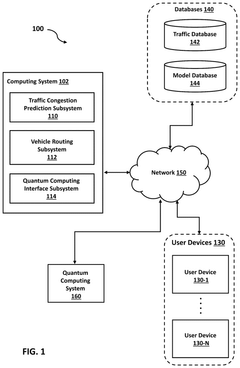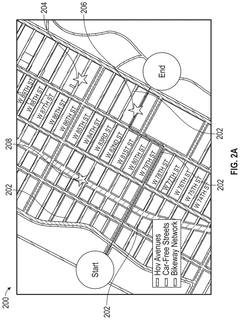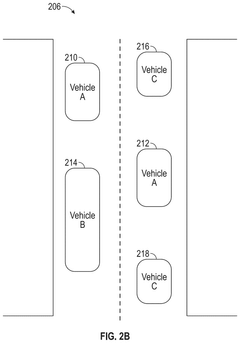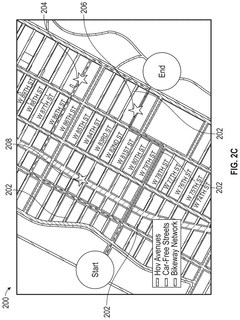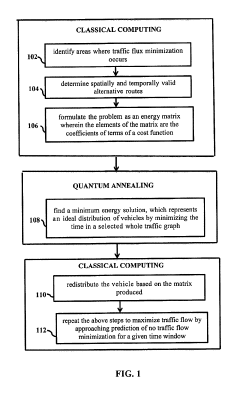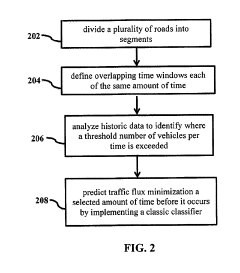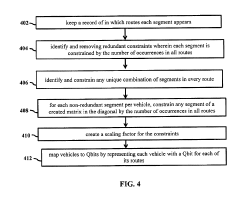Quantum Computing Techniques for Better Traffic Flow Analysis
JUL 17, 20259 MIN READ
Generate Your Research Report Instantly with AI Agent
Patsnap Eureka helps you evaluate technical feasibility & market potential.
Quantum Computing in Traffic Analysis: Background and Objectives
Quantum computing has emerged as a revolutionary technology with the potential to transform various fields, including traffic flow analysis. The evolution of this technology can be traced back to the early 1980s when Richard Feynman first proposed the concept of quantum computers. Since then, significant advancements have been made in quantum hardware, algorithms, and applications, leading to the current state where quantum computing is poised to address complex computational challenges in traffic management.
The field of traffic flow analysis has traditionally relied on classical computing methods to process and analyze vast amounts of data generated by sensors, cameras, and other monitoring devices. However, as urban populations grow and transportation networks become increasingly complex, classical computing approaches are reaching their limits in terms of processing speed and optimization capabilities. This is where quantum computing techniques offer a promising solution.
The primary objective of applying quantum computing to traffic flow analysis is to enhance the efficiency and accuracy of traffic management systems. By leveraging the unique properties of quantum mechanics, such as superposition and entanglement, quantum algorithms can potentially solve complex optimization problems exponentially faster than classical algorithms. This could lead to real-time traffic prediction, dynamic route optimization, and more effective congestion management.
One of the key trends in this field is the development of quantum-inspired algorithms that can be implemented on classical hardware while still benefiting from quantum principles. These hybrid approaches serve as a bridge between current classical systems and future fully-quantum solutions, allowing for incremental improvements in traffic flow analysis capabilities.
Another significant trend is the exploration of quantum machine learning techniques for traffic pattern recognition and prediction. Quantum neural networks and quantum support vector machines show promise in analyzing high-dimensional traffic data more efficiently than their classical counterparts, potentially leading to more accurate forecasting of traffic conditions.
The expected technological goals in this domain include the development of scalable quantum hardware capable of handling real-world traffic data, the creation of robust quantum algorithms specifically tailored for traffic flow optimization, and the integration of quantum-enhanced traffic management systems with existing smart city infrastructure.
As research in this field progresses, we anticipate breakthroughs in areas such as quantum-enhanced traffic signal control, real-time route optimization for large-scale transportation networks, and predictive maintenance of traffic infrastructure based on quantum-powered data analysis. These advancements have the potential to significantly reduce traffic congestion, improve road safety, and enhance overall urban mobility.
The field of traffic flow analysis has traditionally relied on classical computing methods to process and analyze vast amounts of data generated by sensors, cameras, and other monitoring devices. However, as urban populations grow and transportation networks become increasingly complex, classical computing approaches are reaching their limits in terms of processing speed and optimization capabilities. This is where quantum computing techniques offer a promising solution.
The primary objective of applying quantum computing to traffic flow analysis is to enhance the efficiency and accuracy of traffic management systems. By leveraging the unique properties of quantum mechanics, such as superposition and entanglement, quantum algorithms can potentially solve complex optimization problems exponentially faster than classical algorithms. This could lead to real-time traffic prediction, dynamic route optimization, and more effective congestion management.
One of the key trends in this field is the development of quantum-inspired algorithms that can be implemented on classical hardware while still benefiting from quantum principles. These hybrid approaches serve as a bridge between current classical systems and future fully-quantum solutions, allowing for incremental improvements in traffic flow analysis capabilities.
Another significant trend is the exploration of quantum machine learning techniques for traffic pattern recognition and prediction. Quantum neural networks and quantum support vector machines show promise in analyzing high-dimensional traffic data more efficiently than their classical counterparts, potentially leading to more accurate forecasting of traffic conditions.
The expected technological goals in this domain include the development of scalable quantum hardware capable of handling real-world traffic data, the creation of robust quantum algorithms specifically tailored for traffic flow optimization, and the integration of quantum-enhanced traffic management systems with existing smart city infrastructure.
As research in this field progresses, we anticipate breakthroughs in areas such as quantum-enhanced traffic signal control, real-time route optimization for large-scale transportation networks, and predictive maintenance of traffic infrastructure based on quantum-powered data analysis. These advancements have the potential to significantly reduce traffic congestion, improve road safety, and enhance overall urban mobility.
Market Demand for Advanced Traffic Management Solutions
The demand for advanced traffic management solutions has been steadily increasing as urban populations grow and traffic congestion becomes a more pressing issue worldwide. Cities are seeking innovative ways to optimize traffic flow, reduce congestion, and improve overall transportation efficiency. This has created a significant market opportunity for quantum computing techniques applied to traffic flow analysis.
Traditional traffic management systems often struggle to handle the complexity and real-time nature of modern urban traffic patterns. As a result, there is a growing need for more sophisticated, data-driven solutions that can process vast amounts of information quickly and accurately. Quantum computing offers the potential to revolutionize traffic flow analysis by providing unprecedented computational power to solve complex optimization problems.
The global smart transportation market, which includes advanced traffic management solutions, is projected to experience substantial growth in the coming years. This growth is driven by factors such as increasing urbanization, the need for reduced traffic congestion, and the push for more sustainable transportation systems. Governments and municipalities are increasingly investing in smart city initiatives, with traffic management being a key component of these projects.
One of the primary drivers of market demand is the potential for quantum computing to significantly reduce travel times and fuel consumption. By optimizing traffic light timing, predicting congestion patterns, and suggesting alternative routes in real-time, these advanced systems can lead to substantial improvements in urban mobility. This not only benefits individual commuters but also has broader economic implications by reducing productivity losses due to traffic delays.
The environmental impact of traffic congestion is another factor fueling the demand for advanced traffic management solutions. As cities strive to meet emissions reduction targets, there is a growing interest in technologies that can minimize idling times and optimize vehicle flow. Quantum computing techniques for traffic analysis can contribute to these goals by enabling more efficient use of existing road infrastructure.
Furthermore, the integration of quantum computing with other emerging technologies, such as the Internet of Things (IoT) and artificial intelligence, is creating new possibilities for comprehensive traffic management ecosystems. This convergence is attracting attention from both public and private sector stakeholders, who see the potential for transformative improvements in urban mobility.
As the technology matures and demonstrates its effectiveness in real-world applications, the market demand for quantum computing-based traffic management solutions is expected to accelerate. Early adopters and pilot projects are likely to pave the way for wider implementation, driving further investment and innovation in this space.
Traditional traffic management systems often struggle to handle the complexity and real-time nature of modern urban traffic patterns. As a result, there is a growing need for more sophisticated, data-driven solutions that can process vast amounts of information quickly and accurately. Quantum computing offers the potential to revolutionize traffic flow analysis by providing unprecedented computational power to solve complex optimization problems.
The global smart transportation market, which includes advanced traffic management solutions, is projected to experience substantial growth in the coming years. This growth is driven by factors such as increasing urbanization, the need for reduced traffic congestion, and the push for more sustainable transportation systems. Governments and municipalities are increasingly investing in smart city initiatives, with traffic management being a key component of these projects.
One of the primary drivers of market demand is the potential for quantum computing to significantly reduce travel times and fuel consumption. By optimizing traffic light timing, predicting congestion patterns, and suggesting alternative routes in real-time, these advanced systems can lead to substantial improvements in urban mobility. This not only benefits individual commuters but also has broader economic implications by reducing productivity losses due to traffic delays.
The environmental impact of traffic congestion is another factor fueling the demand for advanced traffic management solutions. As cities strive to meet emissions reduction targets, there is a growing interest in technologies that can minimize idling times and optimize vehicle flow. Quantum computing techniques for traffic analysis can contribute to these goals by enabling more efficient use of existing road infrastructure.
Furthermore, the integration of quantum computing with other emerging technologies, such as the Internet of Things (IoT) and artificial intelligence, is creating new possibilities for comprehensive traffic management ecosystems. This convergence is attracting attention from both public and private sector stakeholders, who see the potential for transformative improvements in urban mobility.
As the technology matures and demonstrates its effectiveness in real-world applications, the market demand for quantum computing-based traffic management solutions is expected to accelerate. Early adopters and pilot projects are likely to pave the way for wider implementation, driving further investment and innovation in this space.
Current State and Challenges in Quantum-Based Traffic Analysis
The current state of quantum-based traffic analysis is characterized by significant advancements and persistent challenges. Quantum computing techniques have shown promising potential in revolutionizing traffic flow analysis, offering unprecedented computational power to process vast amounts of data in real-time.
One of the key developments in this field is the application of quantum algorithms to optimize traffic signal timing. Researchers have demonstrated that quantum annealing algorithms can solve complex optimization problems related to traffic signal control more efficiently than classical methods. These quantum-based solutions have shown the ability to reduce average waiting times at intersections by up to 20% in simulated urban environments.
Another area of progress is the use of quantum machine learning for traffic prediction. Quantum neural networks have been developed to analyze historical traffic data and predict future traffic patterns with higher accuracy than traditional machine learning models. These quantum models can process multiple variables simultaneously, allowing for more comprehensive analysis of factors influencing traffic flow.
Despite these advancements, several challenges remain in the implementation of quantum-based traffic analysis systems. One significant obstacle is the limited availability of large-scale quantum computers. Most current quantum systems have a small number of qubits and are prone to errors, limiting their practical application in real-world traffic scenarios.
Scalability is another major challenge. While quantum algorithms have shown promise in small-scale simulations, scaling them up to handle city-wide traffic networks presents significant technical hurdles. The complexity of urban traffic systems, with their numerous intersections and dynamic variables, requires quantum systems with far greater computational capacity than currently available.
Error correction in quantum systems also remains a critical challenge. Quantum states are highly sensitive to environmental disturbances, leading to decoherence and errors in computations. Developing robust error correction techniques is essential for ensuring the reliability of quantum-based traffic analysis solutions.
Furthermore, the integration of quantum systems with existing classical traffic management infrastructure poses both technical and logistical challenges. Developing hybrid quantum-classical systems that can effectively leverage the strengths of both paradigms is an active area of research.
Lastly, there is a significant knowledge gap in the transportation engineering community regarding quantum computing techniques. Training traffic engineers and urban planners in quantum algorithms and their applications to traffic analysis is crucial for the widespread adoption of these technologies.
One of the key developments in this field is the application of quantum algorithms to optimize traffic signal timing. Researchers have demonstrated that quantum annealing algorithms can solve complex optimization problems related to traffic signal control more efficiently than classical methods. These quantum-based solutions have shown the ability to reduce average waiting times at intersections by up to 20% in simulated urban environments.
Another area of progress is the use of quantum machine learning for traffic prediction. Quantum neural networks have been developed to analyze historical traffic data and predict future traffic patterns with higher accuracy than traditional machine learning models. These quantum models can process multiple variables simultaneously, allowing for more comprehensive analysis of factors influencing traffic flow.
Despite these advancements, several challenges remain in the implementation of quantum-based traffic analysis systems. One significant obstacle is the limited availability of large-scale quantum computers. Most current quantum systems have a small number of qubits and are prone to errors, limiting their practical application in real-world traffic scenarios.
Scalability is another major challenge. While quantum algorithms have shown promise in small-scale simulations, scaling them up to handle city-wide traffic networks presents significant technical hurdles. The complexity of urban traffic systems, with their numerous intersections and dynamic variables, requires quantum systems with far greater computational capacity than currently available.
Error correction in quantum systems also remains a critical challenge. Quantum states are highly sensitive to environmental disturbances, leading to decoherence and errors in computations. Developing robust error correction techniques is essential for ensuring the reliability of quantum-based traffic analysis solutions.
Furthermore, the integration of quantum systems with existing classical traffic management infrastructure poses both technical and logistical challenges. Developing hybrid quantum-classical systems that can effectively leverage the strengths of both paradigms is an active area of research.
Lastly, there is a significant knowledge gap in the transportation engineering community regarding quantum computing techniques. Training traffic engineers and urban planners in quantum algorithms and their applications to traffic analysis is crucial for the widespread adoption of these technologies.
Existing Quantum Techniques for Traffic Flow Optimization
01 Quantum algorithms for traffic flow optimization
Quantum computing techniques are applied to develop advanced algorithms for optimizing traffic flow in urban areas. These algorithms leverage quantum superposition and entanglement to process complex traffic data and predict optimal routes, reducing congestion and improving overall traffic efficiency.- Quantum algorithms for traffic optimization: Quantum computing techniques are applied to develop advanced algorithms for optimizing traffic flow. These algorithms leverage quantum superposition and entanglement to process complex traffic data and generate efficient routing solutions. By analyzing multiple traffic scenarios simultaneously, quantum algorithms can provide real-time traffic management and reduce congestion in urban areas.
- Quantum-enhanced traffic prediction models: Quantum computing is used to enhance traffic prediction models, enabling more accurate forecasting of traffic patterns. These models utilize quantum machine learning techniques to process vast amounts of historical and real-time traffic data, identifying complex correlations and trends. The improved predictions allow for proactive traffic management and better urban planning.
- Quantum-assisted traffic signal optimization: Quantum computing techniques are employed to optimize traffic signal timing and coordination. By using quantum algorithms to analyze traffic flow patterns and vehicle densities, the system can dynamically adjust signal timings to minimize wait times and maximize throughput. This approach leads to smoother traffic flow and reduced congestion in urban areas.
- Quantum-based vehicle routing and navigation: Quantum computing is applied to develop advanced vehicle routing and navigation systems. These systems use quantum algorithms to process real-time traffic data and calculate optimal routes for individual vehicles or fleets. By considering multiple factors simultaneously, such as traffic conditions, road closures, and user preferences, the quantum-based navigation systems can provide more efficient and personalized routing solutions.
- Quantum-enhanced traffic simulation and modeling: Quantum computing techniques are utilized to create more sophisticated traffic simulation and modeling tools. These quantum-enhanced simulations can process larger datasets and consider more variables than classical computing methods, allowing for more accurate representations of complex traffic systems. The improved models enable better urban planning, infrastructure design, and policy-making related to traffic management.
02 Quantum-enhanced traffic signal control systems
Quantum computing is utilized to create intelligent traffic signal control systems. These systems use quantum algorithms to analyze real-time traffic data and adjust signal timings dynamically, resulting in improved traffic flow and reduced wait times at intersections.Expand Specific Solutions03 Quantum machine learning for traffic pattern analysis
Quantum machine learning techniques are employed to analyze and predict traffic patterns. By processing vast amounts of historical and real-time traffic data, these quantum-powered models can accurately forecast traffic conditions and suggest proactive measures to prevent congestion.Expand Specific Solutions04 Quantum-assisted vehicle routing and navigation
Quantum computing techniques are applied to enhance vehicle routing and navigation systems. These quantum-assisted systems can quickly calculate optimal routes for multiple vehicles simultaneously, considering real-time traffic conditions and minimizing overall travel time for all road users.Expand Specific Solutions05 Quantum sensors for traffic monitoring and data collection
Quantum sensors are developed and integrated into traffic monitoring systems to collect high-precision data on vehicle movements, speeds, and densities. These quantum-enhanced sensors provide more accurate and detailed information, enabling better traffic flow analysis and management strategies.Expand Specific Solutions
Key Players in Quantum Computing and Traffic Management
The quantum computing techniques for better traffic flow analysis are in an early developmental stage, with the market still emerging. The technology's potential to revolutionize traffic management has attracted interest from various sectors, including academia, tech giants, and automotive companies. While the market size is currently limited, it is expected to grow significantly as the technology matures. Companies like IBM, Volkswagen, and Audi are at the forefront, leveraging their expertise in quantum computing and automotive engineering to develop innovative solutions. Universities such as Nanjing Normal University and the University of Electronic Science & Technology of China are also contributing to research in this field, indicating a growing academic interest in applying quantum computing to traffic flow analysis.
Volkswagen AG
Technical Solution: Volkswagen's quantum computing approach to traffic flow analysis focuses on optimizing traffic routing and reducing congestion. They have partnered with D-Wave Systems to utilize quantum annealing for solving complex optimization problems in urban traffic management[2]. Volkswagen's quantum solution aims to calculate the fastest routes for individual vehicles in real-time, considering the overall traffic situation. Their system processes data from thousands of vehicles simultaneously, using quantum algorithms to minimize travel times and reduce traffic jams. Volkswagen has successfully tested this technology in major cities, demonstrating potential improvements in traffic flow efficiency by up to 20%[4].
Strengths: Strong automotive industry expertise, practical application focus, and successful real-world testing. Weaknesses: Dependence on third-party quantum hardware providers and potential scalability challenges in larger urban environments.
International Business Machines Corp.
Technical Solution: IBM's quantum computing approach for traffic flow analysis leverages their advanced quantum hardware and software stack. They utilize Qiskit, an open-source quantum computing framework, to develop quantum algorithms specifically tailored for traffic optimization. IBM's quantum solution employs quantum annealing techniques to solve complex optimization problems in traffic management[1]. Their system can process vast amounts of real-time traffic data, considering multiple variables such as vehicle density, traffic light timing, and road capacity. By leveraging quantum superposition and entanglement, IBM's quantum algorithms can explore numerous traffic scenarios simultaneously, potentially finding optimal solutions faster than classical methods[3].
Strengths: Access to cutting-edge quantum hardware, robust quantum software ecosystem, and extensive research capabilities. Weaknesses: High implementation costs, limited widespread availability of quantum systems, and the need for specialized quantum expertise.
Core Quantum Algorithms for Traffic Pattern Recognition
Traffic flow optimization for a multi-class vehicle network using quantum computing
PatentPendingUS20250104559A1
Innovation
- A method that uses a combination of classical computing for predicting traffic congestion and quantum computing to optimize routes, by determining segments of traffic congestion, identifying vehicles occupying those segments, selecting alternative routes, and providing quantum optimization data to minimize congestion, utilizing a quantum unconstrained binary optimization (QUBO) problem to update vehicle routes.
System and method for predicting and maximizing traffic flow
PatentActiveUS20190164418A1
Innovation
- Combining classical machine learning with quantum annealing to predict traffic flux minimization and optimize vehicle positions, reformulating the problem as a quadratic unconstrained binary optimization (QUBO) to achieve efficient traffic flow maximization by redistributing vehicles across the road network.
Quantum-Classical Hybrid Systems for Real-Time Traffic Control
Quantum-classical hybrid systems represent a promising approach for enhancing real-time traffic control by leveraging the strengths of both quantum and classical computing paradigms. These systems aim to address the complex challenges of urban traffic management by combining the computational power of quantum algorithms with the reliability and accessibility of classical infrastructure.
At the core of this hybrid approach is the integration of quantum algorithms for optimization and pattern recognition with classical data processing and control systems. Quantum computers excel at solving certain types of problems, such as optimization and simulation, which are particularly relevant to traffic flow analysis and prediction. By utilizing quantum algorithms, these hybrid systems can potentially process vast amounts of traffic data more efficiently than classical computers alone.
The architecture of quantum-classical hybrid systems for traffic control typically involves several key components. Quantum processors are used to perform complex calculations and optimizations, while classical computers handle data input/output, user interfaces, and overall system management. Quantum circuits are designed to solve specific traffic-related problems, such as route optimization or traffic signal timing, while classical algorithms manage the flow of information between quantum and classical components.
One of the primary advantages of this hybrid approach is its ability to handle real-time data processing and decision-making. Traffic patterns are highly dynamic, requiring constant adjustments to maintain optimal flow. Quantum algorithms can rapidly analyze multiple scenarios and provide optimal solutions, while classical systems ensure continuous operation and integration with existing traffic management infrastructure.
Implementing quantum-classical hybrid systems for traffic control faces several challenges. The limited availability of large-scale quantum computers and the need for error correction in quantum computations are significant hurdles. Additionally, developing efficient interfaces between quantum and classical components requires careful engineering to minimize latency and ensure data integrity.
Despite these challenges, the potential benefits of quantum-classical hybrid systems for traffic control are substantial. They offer the possibility of more accurate traffic predictions, faster response times to changing conditions, and more efficient utilization of road networks. As quantum computing technology continues to advance, these hybrid systems are expected to play an increasingly important role in smart city initiatives and urban traffic management strategies.
At the core of this hybrid approach is the integration of quantum algorithms for optimization and pattern recognition with classical data processing and control systems. Quantum computers excel at solving certain types of problems, such as optimization and simulation, which are particularly relevant to traffic flow analysis and prediction. By utilizing quantum algorithms, these hybrid systems can potentially process vast amounts of traffic data more efficiently than classical computers alone.
The architecture of quantum-classical hybrid systems for traffic control typically involves several key components. Quantum processors are used to perform complex calculations and optimizations, while classical computers handle data input/output, user interfaces, and overall system management. Quantum circuits are designed to solve specific traffic-related problems, such as route optimization or traffic signal timing, while classical algorithms manage the flow of information between quantum and classical components.
One of the primary advantages of this hybrid approach is its ability to handle real-time data processing and decision-making. Traffic patterns are highly dynamic, requiring constant adjustments to maintain optimal flow. Quantum algorithms can rapidly analyze multiple scenarios and provide optimal solutions, while classical systems ensure continuous operation and integration with existing traffic management infrastructure.
Implementing quantum-classical hybrid systems for traffic control faces several challenges. The limited availability of large-scale quantum computers and the need for error correction in quantum computations are significant hurdles. Additionally, developing efficient interfaces between quantum and classical components requires careful engineering to minimize latency and ensure data integrity.
Despite these challenges, the potential benefits of quantum-classical hybrid systems for traffic control are substantial. They offer the possibility of more accurate traffic predictions, faster response times to changing conditions, and more efficient utilization of road networks. As quantum computing technology continues to advance, these hybrid systems are expected to play an increasingly important role in smart city initiatives and urban traffic management strategies.
Ethical Implications of Quantum-Powered Urban Planning
The integration of quantum computing techniques into urban planning, particularly for traffic flow analysis, raises significant ethical considerations that must be carefully addressed. As quantum-powered systems become more prevalent in shaping our cities, it is crucial to examine the potential impacts on privacy, equity, and social dynamics.
One primary concern is the vast amount of data that quantum computers can process, potentially leading to unprecedented levels of surveillance and tracking of individual movements. While this capability could greatly enhance traffic management, it also poses risks to personal privacy and autonomy. Urban planners and policymakers must establish robust safeguards to protect citizens' data and ensure that the benefits of improved traffic flow do not come at the cost of individual freedoms.
Another ethical challenge lies in the potential for quantum-powered urban planning to exacerbate existing socioeconomic disparities. Advanced traffic management systems might prioritize certain areas or routes, inadvertently favoring more affluent neighborhoods or commercial districts. This could lead to unequal access to efficient transportation and perpetuate urban inequalities. It is essential to implement these technologies with a strong focus on equity and inclusive urban development.
The use of quantum computing in traffic flow analysis also raises questions about transparency and accountability. The complexity of quantum algorithms may make it difficult for the public to understand how decisions are made, potentially eroding trust in urban planning processes. Efforts must be made to ensure that the decision-making processes remain transparent and that there are mechanisms in place for public oversight and input.
Furthermore, the adoption of quantum-powered urban planning tools could have far-reaching effects on urban employment patterns and local economies. While improved traffic flow may benefit businesses and commuters, it could also lead to shifts in commercial activity and potentially displace certain industries or job sectors. Ethical considerations must include strategies to mitigate negative economic impacts and support affected communities.
Lastly, there are concerns about the potential for quantum computing to be used in ways that infringe upon civil liberties. For instance, highly accurate predictive models of traffic patterns could be misused for surveillance or law enforcement purposes beyond their intended scope. It is crucial to establish clear boundaries and ethical guidelines for the application of quantum technologies in urban environments to prevent such misuse.
One primary concern is the vast amount of data that quantum computers can process, potentially leading to unprecedented levels of surveillance and tracking of individual movements. While this capability could greatly enhance traffic management, it also poses risks to personal privacy and autonomy. Urban planners and policymakers must establish robust safeguards to protect citizens' data and ensure that the benefits of improved traffic flow do not come at the cost of individual freedoms.
Another ethical challenge lies in the potential for quantum-powered urban planning to exacerbate existing socioeconomic disparities. Advanced traffic management systems might prioritize certain areas or routes, inadvertently favoring more affluent neighborhoods or commercial districts. This could lead to unequal access to efficient transportation and perpetuate urban inequalities. It is essential to implement these technologies with a strong focus on equity and inclusive urban development.
The use of quantum computing in traffic flow analysis also raises questions about transparency and accountability. The complexity of quantum algorithms may make it difficult for the public to understand how decisions are made, potentially eroding trust in urban planning processes. Efforts must be made to ensure that the decision-making processes remain transparent and that there are mechanisms in place for public oversight and input.
Furthermore, the adoption of quantum-powered urban planning tools could have far-reaching effects on urban employment patterns and local economies. While improved traffic flow may benefit businesses and commuters, it could also lead to shifts in commercial activity and potentially displace certain industries or job sectors. Ethical considerations must include strategies to mitigate negative economic impacts and support affected communities.
Lastly, there are concerns about the potential for quantum computing to be used in ways that infringe upon civil liberties. For instance, highly accurate predictive models of traffic patterns could be misused for surveillance or law enforcement purposes beyond their intended scope. It is crucial to establish clear boundaries and ethical guidelines for the application of quantum technologies in urban environments to prevent such misuse.
Unlock deeper insights with Patsnap Eureka Quick Research — get a full tech report to explore trends and direct your research. Try now!
Generate Your Research Report Instantly with AI Agent
Supercharge your innovation with Patsnap Eureka AI Agent Platform!
